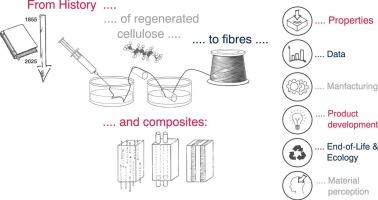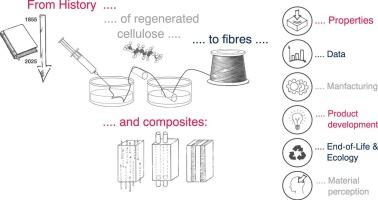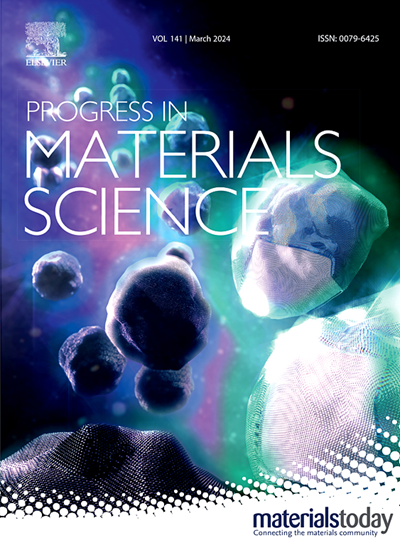Regenerated cellulose fibres and their composites: From fundamental properties to advanced applications
IF 40
1区 材料科学
Q1 MATERIALS SCIENCE, MULTIDISCIPLINARY
引用次数: 0
Abstract
Despite their good mechanical properties, especially their toughness, there are hardly any industrial applications for regenerated cellulose fibre-reinforced composites (RCFCs) apart from the classic elastomer applications in the automotive sector (tyres and hoses). The present review demonstrates that although there is some research work dealing with RCFCs, the amount of data is considered to be rather low compared to, e.g., natural fibre-reinforced composites. This review paper provides an overview of different regenerated cellulose fibres (RCFs) and their areas of application, as well as the processing of RCFs into RCFCs. It shows a comprehensive comparison of the mechanical properties of different fibre types and semi-finished products in various polymer matrices, an assessment of biodegradation and durability, and an overview of applications. RCFCs demonstrate significant potential for lightweight construction of composite materials, particularly in applications involving surface loads under bending and high toughness, due to their low density and environmental benefits compared to, e.g., glass fibres. However, further optimisation of stiffness and tensile strength is required to enhance their competitiveness for highly stressed composite materials, while increased attention to material perception is essential for successful product development and market adoption. Further research should be focused on standardising processing methods and achievable properties to transfer the technology to advanced industrial applications.


再生纤维素纤维及其复合材料:从基本特性到高级应用
尽管再生纤维素纤维增强复合材料(rcfc)具有良好的机械性能,特别是韧性,但除了汽车领域(轮胎和软管)的经典弹性体应用外,几乎没有任何工业应用。目前的审查表明,虽然有一些关于RCFCs的研究工作,但与天然纤维增强复合材料等相比,数据量被认为相当少。本文综述了再生纤维素纤维(rcf)的不同种类及其应用领域,以及将rcf加工成RCFCs的方法。它全面比较了不同纤维类型和半成品在各种聚合物基质中的机械性能,评估了生物降解和耐久性,并概述了应用。与玻璃纤维相比,RCFCs具有低密度和环境效益,因此在复合材料轻量化结构方面具有巨大潜力,特别是在涉及弯曲和高韧性表面载荷的应用中。然而,需要进一步优化刚度和抗拉强度,以提高他们在高应力复合材料方面的竞争力,同时增加对材料感知的关注,对于成功的产品开发和市场采用至关重要。进一步的研究应集中在标准化加工方法和可实现的特性,以便将该技术转移到先进的工业应用。
本文章由计算机程序翻译,如有差异,请以英文原文为准。
求助全文
约1分钟内获得全文
求助全文
来源期刊

Progress in Materials Science
工程技术-材料科学:综合
CiteScore
59.60
自引率
0.80%
发文量
101
审稿时长
11.4 months
期刊介绍:
Progress in Materials Science is a journal that publishes authoritative and critical reviews of recent advances in the science of materials. The focus of the journal is on the fundamental aspects of materials science, particularly those concerning microstructure and nanostructure and their relationship to properties. Emphasis is also placed on the thermodynamics, kinetics, mechanisms, and modeling of processes within materials, as well as the understanding of material properties in engineering and other applications.
The journal welcomes reviews from authors who are active leaders in the field of materials science and have a strong scientific track record. Materials of interest include metallic, ceramic, polymeric, biological, medical, and composite materials in all forms.
Manuscripts submitted to Progress in Materials Science are generally longer than those found in other research journals. While the focus is on invited reviews, interested authors may submit a proposal for consideration. Non-invited manuscripts are required to be preceded by the submission of a proposal. Authors publishing in Progress in Materials Science have the option to publish their research via subscription or open access. Open access publication requires the author or research funder to meet a publication fee (APC).
Abstracting and indexing services for Progress in Materials Science include Current Contents, Science Citation Index Expanded, Materials Science Citation Index, Chemical Abstracts, Engineering Index, INSPEC, and Scopus.
 求助内容:
求助内容: 应助结果提醒方式:
应助结果提醒方式:


